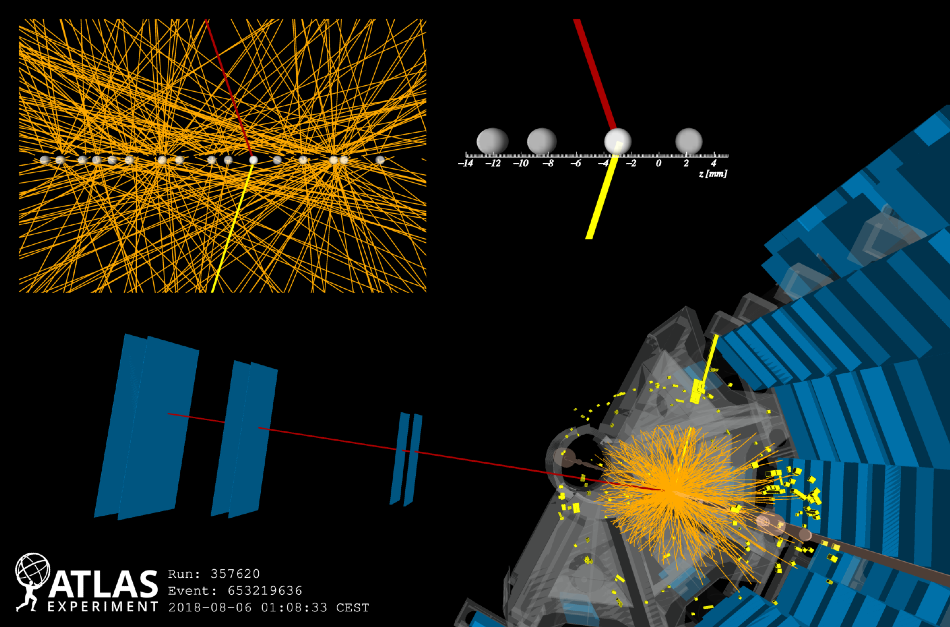Aug 6 2020
The first-ever observation of the production of pairs of W bosons from photon collisions has been presented by the ATLAS collaboration at the International Conference on High-Energy Physics (ICHEP 2020).
 A 2018 ATLAS event display consistent with the production of a pair of W bosons from two photons, and the subsequent decay of the W bosons into a muon and an electron (visible in the detector) and neutrinos (not detected). Image Credit: CERN.
A 2018 ATLAS event display consistent with the production of a pair of W bosons from two photons, and the subsequent decay of the W bosons into a muon and an electron (visible in the detector) and neutrinos (not detected). Image Credit: CERN.
W bosons are elementary particles that carry the weak force, which is one of the four fundamental forces.
The study findings offer a new technique to use the LHC, for example, as a high-energy photon collider that directly investigates electroweak interactions. It validates one of the key predictions of electroweak theory—which proposes that force carriers have the ability to interact with themselves—and offers new means to investigate it.
The laws of classical electrodynamics propose that two intersecting light beams do not absorb, deflect, or disrupt one another. But based on the effects of quantum electrodynamics (QED)—the theory that describes the interaction between light and matter—interactions among photons is allowed.
Photons that interact at high energies have already been investigated at the LHC. For example, light-by-light “scattering”, in which a pair of photons interact by generating another pair of photons, is one of the oldest hypotheses of QED.
In 2017, ATLAS reported the first-ever direct evidence of light-by-light scattering, which was achieved by leveraging the strong electromagnetic fields around lead ions in high-energy lead-lead collisions. This process was further studied by ATLAS in 2019 and 2020 by measuring its properties.
The new findings described at this conference are sensitive to another unique phenomenon where two photons interact with each other to form two W bosons with an opposite electric charge by (among others) the interaction of four force carriers.
Quasi-real photons in the proton beams produce a pair of W bosons by scattering off one another. In 2016, ATLAS and CMS reported the first-ever investigation of this phenomenon, using data recorded during LHC Run 1. However, a larger dataset was necessary to observe it without any doubt.
The observation was achieved with a largely significant statistical evidence of 8.4 standard deviations, with respect to a negligible chance of being caused by a statistical fluctuation. Physicists at the ATLAS collaboration employed a significantly larger dataset obtained during Run 2—the four-year data collection in the LHC that concluded in 2018—and created a tailored analysis technique.
Due to the kind of the interaction process, the only particle tracks that could be observed in the central detector were the products of decay of the two W bosons—an electron and a muon that had opposite electric charge.
Moreover, W-boson pairs can be directly synthesized through interactions between gluons and quarks in the colliding protons far more often compared to those through photon-photon interactions. However, additional tracks caused by strong interaction processes accompany these pairs. Thus, to visualize this rare phenomenon, the ATLAS physicists had to cautiously disentangle the collision tracks.
This observation opens up a new facet of experimental exploration at the LHC using photons in the initial state. It is unique as it only involves couplings among electroweak force carriers in the strong-interaction-dominated environment of the LHC. With larger future datasets it can be used to probe in a clean way the electroweak gauge structure and possible contributions of new physics.
Karl Jakobs, Spokesperson, ATLAS collaboration
The new findings actually confirm one of the key hypotheses of electroweak theory—which notes that apart from interacting with ordinary particles of matter, the force carriers, also called gauge bosons—which include the W bosons, the photon, and the Z boson—also interact with each other.
Collisions of photons will offer a new means to test the Standard Model and to explore for new physics, which is essential to gain better insights into the Universe.